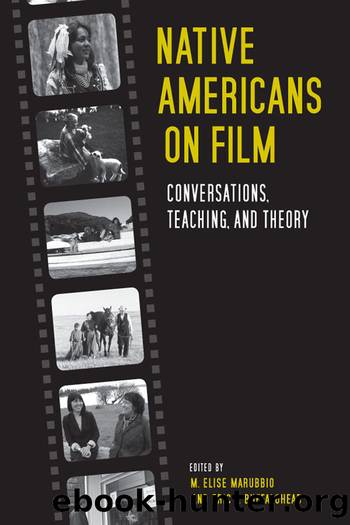Native Americans on Film by M. Elise Marubbio

Author:M. Elise Marubbio
Language: eng
Format: epub
ISBN: 9780813140346
Publisher: The University Press of Kentucky
A shot–reverse shot shows Seymour split into two physical selves in The Business of Fancydancing.
In his “mind-space,” Seymour removes the signifi ers of his Native identity in The Business of Fancydancing.
The last shot: living with the reality of cultural dislocation in The Business of Fancydancing.
This pervasive pessimism about hybrid identities continues in the film’s ending. No matter how fluid the film’s geography, Alexie had to choose a final shot, and the fact that the final shot is Seymour in Seattle with Steven—having made his choice—underscores a melancholy aspect of the film’s message: while one may psychically inhabit many geographies, one can be physically present only in one. This last shot contrasts the different ways the two characters experience the same moment and thus continues the film’s interest in perspective. When combined with the spectator’s independent observation of Seymour and Steven, the shot offers an assemblage of points of view that are greater than one character, or, more important, than one cultural identity—but instead of unified omniscience, the points of view remain distinct and unassimilated. Thus the nomadic viewing position does not allow an easy exit from the film, a feeling of totality and resolution. Seymour has chosen in which place he will live, and the spectator, having experienced the multiple geographies and cultures between which he lives, understands that either choice, reservation or arty Seattle, results in some loss.23 But we also see the good sides of both places: while Fancydancing does not encourage spectatorial affection toward Seymour’s white audiences, it does portray his lover Steven as fairly sympathetic. Since Steven is the prime representative of the hip Seattle art world in which Seymour lives, this depiction renders the cultural landscape of “artistic Seattle” a plausible choice for Seymour. When the film cuts to scenes on the reservation without Seymour, it underscores the strong bonds between the residents that form a true community, which I discuss more below. These varied place-based identifications accumulate and at the film’s end, they cause us to consider both the liberating and wearying effects of cultural hybridity.24
Download
This site does not store any files on its server. We only index and link to content provided by other sites. Please contact the content providers to delete copyright contents if any and email us, we'll remove relevant links or contents immediately.
| African-American Studies | Asian American Studies |
| Disabled | Ethnic Studies |
| Hispanic American Studies | LGBT |
| Minority Studies | Native American Studies |
Cecilia; Or, Memoirs of an Heiress — Volume 1 by Fanny Burney(31327)
Cecilia; Or, Memoirs of an Heiress — Volume 3 by Fanny Burney(30929)
Cecilia; Or, Memoirs of an Heiress — Volume 2 by Fanny Burney(30886)
The Great Music City by Andrea Baker(21197)
We're Going to Need More Wine by Gabrielle Union(18067)
Bombshells: Glamour Girls of a Lifetime by Sullivan Steve(13102)
Pimp by Iceberg Slim(12924)
All the Missing Girls by Megan Miranda(12741)
Fifty Shades Freed by E L James(12445)
Norse Mythology by Gaiman Neil(11877)
Talking to Strangers by Malcolm Gladwell(11865)
Crazy Rich Asians by Kevin Kwan(8343)
Mindhunter: Inside the FBI's Elite Serial Crime Unit by John E. Douglas & Mark Olshaker(7831)
The Lost Art of Listening by Michael P. Nichols(6465)
Enlightenment Now: The Case for Reason, Science, Humanism, and Progress by Steven Pinker(6404)
Bad Blood by John Carreyrou(5763)
The Four Agreements by Don Miguel Ruiz(5504)
Weapons of Math Destruction by Cathy O'Neil(5032)
We Need to Talk by Celeste Headlee(4863)
